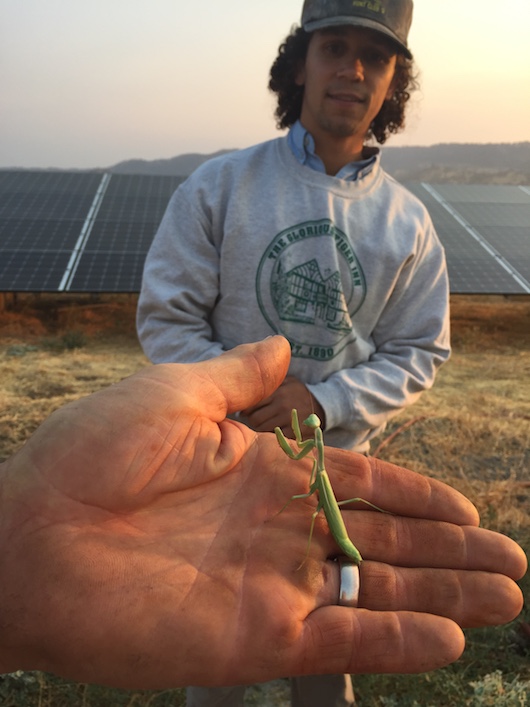
Paul and Ben found a Praying Mantis — see how it is preparing to pray?
Hedgerows –
About 30 years ago, we planted our first line of native shrubs and trees along the boundary of one of the southernmost fields at Full Belly Farm. For awhile, we planted a new hedgerow every couple of years, and maintained them during the year, making sure that the young plants had gotten established and that when something died, we filled in the gaps. Now we do very little to maintain the hedgerows and we haven’t planted a new one in years. There are some gaps along the hedges, and some non-native plants have made their way in, but the oaks and elderberry trees in some of the oldest hedgerows are 50-feet tall and the manzanitas and redbuds have filled out nicely.
We used native plants because if they can live through the hot, dry summer in the hills above the farm, they also don’t want much water when they become domesticated in a hedgerow. One of the reasons that we were interested in hedgerows was because we wanted to encourage beneficial insects that might need habitat on the farm. We are actively working in our fields six days a week — it made sense that native wasps and bees that pollinate plants, and beneficial insects that help to manage pests might like to hide in undisturbed areas of the hedgerow, among the coyote bush, quail bush, and snowberry.
I have a deep memory from my childhood, when visiting Devon, England with my family, that my sister and I spent a long afternoon walking along country roads lined with hedges. The hedgerows in England are of a completely different class than the hedgerows here. A well managed British hedgerow is thick and bushy, an impenetrable barrier to sheep and cattle and a haven for wildlife. There are a set of official criteria used to define a healthy English hedgerow – the hedge must have no more than 10% gaps and no more than 10% non-native species, among other things.
Between 1950 and 1975, thousands of miles of English hedges were bulldozed. They were in the way of roads and urban development and agriculture was changing. In fact, the hedges and woodlots leftover from traditional agriculture were a complete nuisance to farmers who viewed them as non-productive.
The art and science of “laying” an English hedge involves making cuts at the base of trees and shrubs, bending the branches down to the ground and then layering them on top of each other. This skill takes years to learn. There is a National Hedge Laying Championship every year when the masters show off their skill. Hedges in England are part of the historical record and cultural legacy. A quarter of them in Devon where my sister and I walked, are thought to be 800 or 900 years old! Some are underlain by ruins from the Bronze age four thousand years ago.
According to a 2014 National Geographic article, hedges can assist in mitigating climate change: “Each kilometer of a new hedgerow has the capacity to store 1,323 to 1,764 pounds of carbon dioxide per year for up to 20 years.” California’s Healthy Soils program has recognized the climate benefits of planting hedgerows, and has been able to quantify the carbon sequestration that is achieved in various parts of California when hedgerows are planted and maintained.
Wouldn’t it be great if we could do hedges more like they do in Great Britain! Plant the hedge with a 500-year timeline in mind and provide sufficient support for the effort so that native hedges criss-crossed the rural California countryside, providing a corridor for beneficial wildlife, capturing various types of pollution, preventing soil loss and regulating water flows. That would sequester a lot of carbon permanently and besides, it’s such a beautiful vision!
—Judith Redmond

Paul and Ben are finding out the depth of water in this well. A ruled tape with a water sensor is sent down into the shaft. When it hits water, it chimes.

Amon and his young Almond trees.
